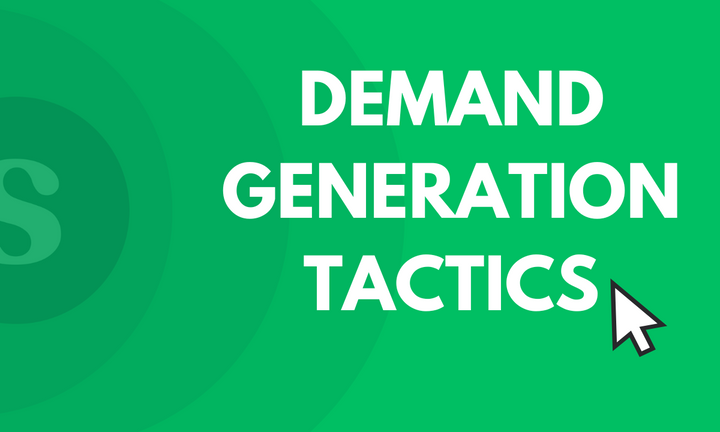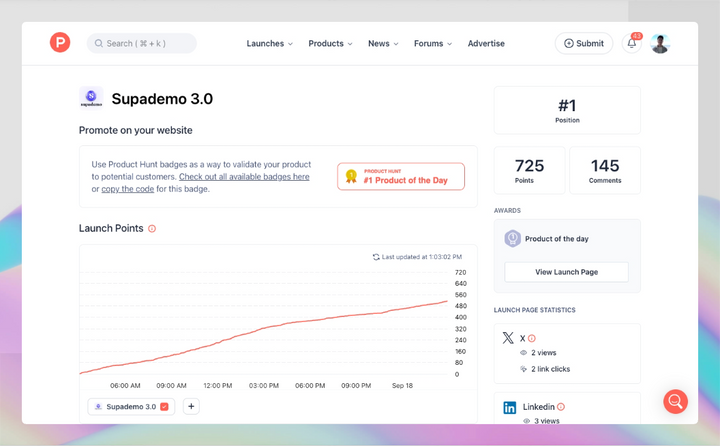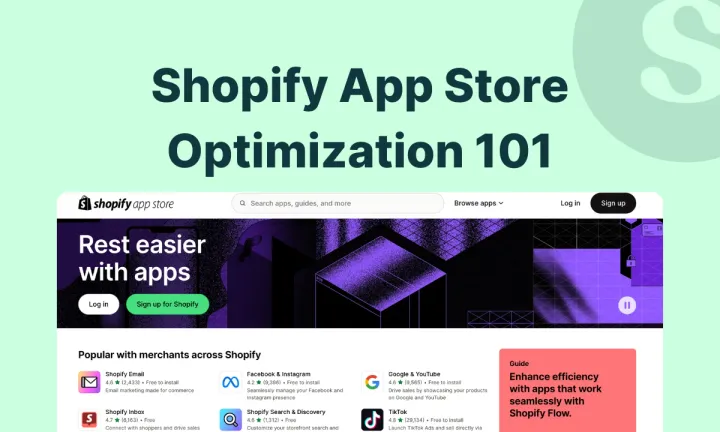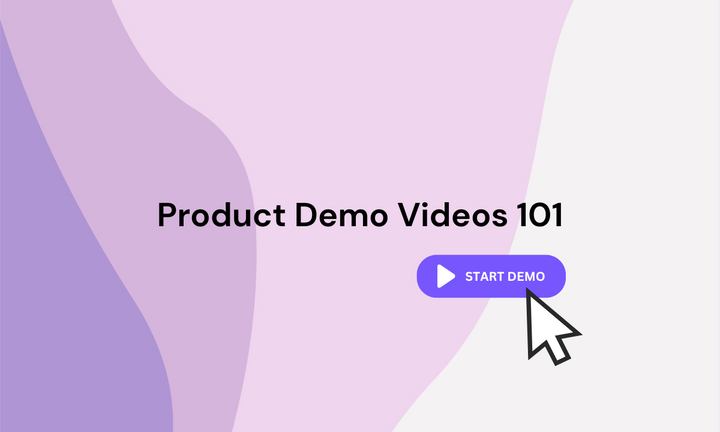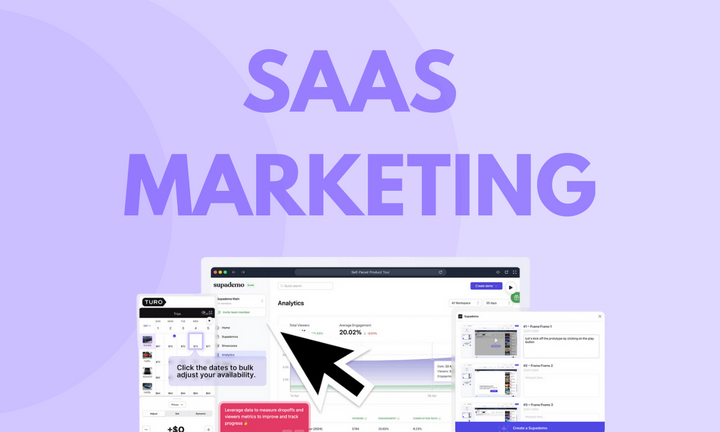Ever feel like you're shouting into the void with your marketing efforts? You're creating content, running campaigns, and hosting events - but are you really generating true demand for your product?
Here's the thing: demand generation isn't just about collecting leads or filling your pipeline. It's about creating genuine interest in your solution and making your product the obvious choice for solving your customers' problems.
In this guide, we'll break down everything you need to know about building a demand generation strategy that actually works. From content marketing to interactive demos, we'll show you proven tactics that help you attract the right prospects and turn them into loyal customers.
What is Demand Generation
Demand generation is a comprehensive marketing strategy that creates awareness and interest in your product or service. Unlike traditional lead generation that focuses on quantity, demand generation is about attracting the right prospects who are more likely to become customers.
• Creates market awareness and buzz
• Educates target audience about solutions
• Drives high-quality leads and opportunities
• Integrates multiple marketing channels
• Focuses on solving customer pain points
The goal is simple: make your solution the obvious choice for solving your customer's problems. This is achieved by weaving together various marketing efforts to educate, engage, and convert potential customers effectively.
Demand Generation vs. Pipeline Generation vs. Sales Pipeline vs. Lead Generation
Understanding the distinctions between demand generation, pipeline generation, sales pipeline, and lead generation is crucial for building an effective revenue strategy.
Let's break down how each component serves a unique purpose in your business growth:
| Demand Generation | Pipeline Generation | Sales Pipeline | Lead Generation | |
|---|---|---|---|---|
| Goal | Create market awareness and interest in your solution, establishing brand authority | Convert interest into qualified opportunities with buying intent | Move opportunities through structured sales stages to close | Collect contact information from potential customers |
| Owned by | Marketing | Marketing & Sales | Sales | Marketing |
| Activities | • Thought leadership content • Interactive demos • Educational webinars • Social proof • Brand awareness |
• Personalized outreach • Product tours • Solution consulting • Case studies |
• Sales presentations • Negotiations • Proposals • Contract reviews |
• Forms • Landing pages • Social campaigns • Basic content |
| Metrics | • Brand awareness • Website traffic • Content engagement • Demo requests |
• Qualified opportunities • Pipeline velocity • Conversion rates |
• Deal size • Close rates • Sales cycle length |
• Number of leads • Cost per lead • Form submissions |
9 demand generation strategies you need to try
Let's explore nine proven strategies that can help you create genuine interest in your product and attract qualified leads.
1. Content marketing: Building your demand generation foundation
Content marketing is the cornerstone of any successful demand-generation strategy.
This approach not only generates initial interest but also nurtures leads through the demand generation funnel.
• Build brand awareness and establish thought leadership
• Educate prospects about industry challenges and solutions
• Generate organic traffic through search engine optimization
• Nurture leads with valuable insights and resources
• Create share-worthy assets that expand your reach
Okay, but where do you even begin?
To leverage content marketing for demand generation, follow these proven steps:
1. Map Content to Buyer Journey: Align your content with each stage of the demand generation funnel:

2. Focus on Pain Points: Create content that directly addresses your target audience's challenges. For example, if you're targeting B2B software companies, your content might address:
- Scaling customer onboarding
- Reducing customer churn
- Improving product adoption
- Streamlining sales processes
Consider this blog post on customer data by HubSpot. The guide demonstrates the above-mentioned points perfectly:
👍🏻 Offers practical advice
👍🏻 Softly positions HubSpot CRM as a potential solution
👍🏻 Prioritizes reader value over direct selling
3. Choose Strategic Content Types: Today, customers are bombarded with hundreds of marketing messages daily, the right sales collateral can be the difference between blending into the background and standing out as a must-have solution.

Diversify your content portfolio with:
- Blog posts and articles
- Whitepapers and ebooks
- Video tutorials and webinars
- Interactive demos and product tours
- Podcasts and audio content
- Infographics and visual content
4. Establish Distribution Channels: Determine where your target audience consumes content and be present there:
- Company blog and website
- Email newsletters
- Social media platforms
- Industry publications
- Partner websites
- Online communities
2. Lead Scoring
Lead scoring helps you identify and prioritize your most promising opportunities.
• Identifies sales-ready leads with precision
• Reduces time wasted on unqualified prospects
• Aligns marketing and sales efforts
• Increases conversion rates
• Optimizes resource allocation
Awesome, but how do you get started with lead scoring for effect demand generation?
Let's break down the essential components of an effective lead-scoring system:
| Stage | Scoring Criteria | Example Points |
|---|---|---|
| Demographic Fit | Company size, industry, location | 0-30 points |
| Behavioral Signals | Website visits, content downloads | 0-40 points |
| Engagement Level | Email opens, social interaction | 0-20 points |
| Purchase Intent | Demo requests, pricing page visits | 0-50 points |
1. Profile matching
Start by scoring how well leads match your ideal customer profile:
👍🏻Company size aligns with your target market
👍🏻 Industry matches your focus sectors
👍🏻 Budget capacity meets your solution's price point
👍🏻 Technology stack compatibility
👍🏻 Geographic location fits your service area
2. Behavioral tracking
Monitor and score prospect actions that indicate interest:
👍🏻Time spent on key pages
👍🏻 Resource downloads (like ebooks, reports, etc.)
👍🏻 Blog engagement
👍🏻 Email interaction rates (opens, clicks, replies)
👍🏻 Social media engagement
3. Engagement scoring
Measure the depth and frequency of interactions:
4. Intent signals
Track actions that indicate buying readiness:
👍🏻 Multiple team members engaging
👍🏻 Competitive comparison page visits
👍🏻 Pricing page exploration
👍🏻 Direct sales team contact
👍🏻 Feature-specific inquiries
Too much to digest? Here's a practical approach to getting started:
- Define Your Baseline
Start with basic scoring criteria. Foe example:
• Demographics/firmographics (0-30 points)
• Online behavior (0-40 points)
• Email engagement (0-20 points)
• Sales interactions (0-50 points - Set Thresholds
Establish clear scoring boundaries. For example:
• 0-40: Early stage prospect
• 41-70: Nurture stage
• 71-100: Sales-ready lead
• 100+: Hot opportunity
3. Account-Based Marketing
Account-based marketing (ABM) transforms traditional demand generation by focusing on quality over quantity. Instead of casting a wide net, ABM helps you create personalized experiences for high-value target accounts, dramatically increasing engagement and conversion rates.
• Focuses resources on best-fit accounts
• Creates highly personalized buying experiences
• Aligns sales and marketing efforts
• Improves ROI on marketing spend
• Increases deal sizes and conversion rates
Let's break down the key components of successful account-based marketing:
| ABM Component | Key Elements |
|---|---|
|
1. Identify Target Accounts
Creating ideal account profile
|
• Revenue potential • Industry fit • Technology compatibility • Growth trajectory • Cultural alignment • Budget capacity |
|
2. Map Key Decision Makers
Understanding buying committee
|
• Economic buyers • Technical evaluators • End users • Industry influencers • Project champions |
|
3. Create Personalized Content
Account-specific materials
|
• Custom landing pages • Personalized product demos • Industry-specific case studies • ROI calculators with company data • Tailored solution proposals |
|
4. Multi-Channel Engagement
Deployment touchpoints
|
• Targeted advertising • Personalized email sequences • Custom event invitations • Direct mail campaigns • Social media engagement • Interactive product tours |
Here's a practical framework to get started:
- Start small
Begin with a pilot program:
• Select 5-10 target accounts
• Define clear success metrics
• Test different approaches
• Document learnings
• Scale what works - Coordinate teams
Align sales and marketing efforts:
• Create shared account plans
• Define clear roles
• Establish communication channels
• Track joint metrics
• Regular strategy reviews
Check out a few high-converting ABM examples here.
4. Don't overlook social media channels
Social media has evolved from a simple networking tool to a powerful demand generation engine. When leveraged strategically, these platforms help you build authentic connections with your target audience while driving meaningful engagement and brand awareness.
Focus your efforts where your audience is most active:
- LinkedIn: Professional networking, thought leadership content, and B2B relationships
- Twitter: Real-time industry discussions and quick updates
- Instagram: Visual storytelling and brand personality
- YouTube: Product demonstrations and educational content
5. Double-down on email marketing
Email remains one of the most effective channels for demand generation, offering a direct line to your prospects' inboxes. But in today's crowded inbox environment, strategic optimization—including using a reliable mail tester to ensure your emails land in inboxes—is key to standing out..
Here are two strategies to transform your email marketing strategy
- Personalization
• Use dynamic content based on user behavior
• Segment lists by industry, role, and interests
• Customize subject lines for higher open rates
• Include interactive product demos relevant to each segment - Use persuasive content
• Share valuable insights, not just promotional content
• Include clear, compelling calls-to-action
• Create mobile-responsive templates
• Test different deployment times for optimal engagement
Remember: Every email should deliver clear value to your subscribers, moving them naturally through your demand generation funnel.
• Open rates
• Click-through rates
• Conversion rates
• Unsubscribe rates
• Spam complaints
• Engagement trends
6. Consider event marketing
Events are a powerful way to get your brand out there and connect with potential customers. Whether you're hosting a webinar or speaking at an industry conference, events help you build credibility and showcase your expertise.
• You get to meet prospects face-to-face
• You can demonstrate your knowledge
• You connect with qualified leads
• You build trust with your audience
• You create lasting relationships
Don't feel pressured to go big right away. Start with smaller events like focused webinars or local meetups. The key is making genuine connections, not just collecting business cards.
Pro tip: Want to make your events more engaging? Include interactive product demos in your presentations. It gives attendees a real feel for your solution.
7. Prioritize intent data to find ready-to-buy customers
Intent data helps you spot potential buyers based on their online behavior and research patterns. It's like having a radar that shows you exactly who's in the market for your product.
• Which companies are researching your solution
• What problems they're trying to solve
• When they're most likely to buy
• How to personalize your approach
• Where to focus your efforts
The numbers speak for themselves: 91% of large companies now use intent data to find and connect with potential customers. Why? Because it works. You can spot buying signals early, create more relevant content, and reach out at just the right moment.
8. Integrate CRM and marketing automation

As your demand generation efforts grow, managing everything manually becomes impossible. The key is choosing tools that work well together and support your demand generation goals. When your systems talk to each other, you can focus on strategy while automation handles the details.
With the right demand generation tools working together, you can:
- Run targeted email campaigns
- Schedule social media content
- Track prospect engagement
- Measure campaign performance
- Nurture leads automatically
9. Improve your demand funnel framework
Think of your demand funnel as a GPS for guiding prospects from awareness to purchase. By understanding each stage, you can better support customers throughout their buying journey.
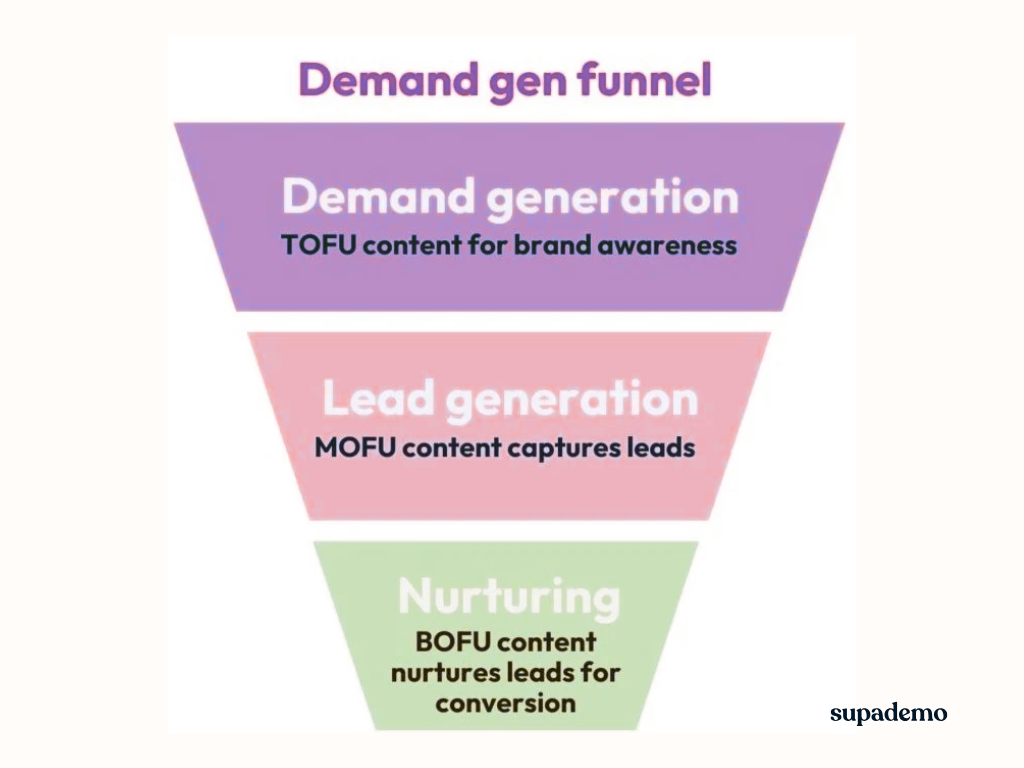
Every business's funnel looks different, so focus on what works for your unique audience and solution. The key is making each stage smooth and valuable for your prospects.
Drive Results with Interactive Demos in Your Demand Generation Strategy
The success of your demand generation strategy hinges on your ability to showcase value early and often in the buyer's journey. While traditional methods like content marketing and email campaigns lay the foundation, modern buyers expect more hands-on experiences before committing to a purchase.

This is where interactive product demos become a game-changer for your demand generation efforts. By allowing prospects to experience your product's value firsthand, you can:
• Qualify leads more effectively
• Build trust through transparency
• Scale your demand generation efforts
Here's an example of what an interactive demo is:
Supademo helps you create and share interactive product demos that engage prospects at every stage of your demand generation funnel. From early-stage awareness content to detailed product tours, you can showcase your solution's value without overwhelming your prospects.
Whether you're:
- Running ABM campaigns
- Nurturing email leads
- Boosting social media engagement
- Supporting content marketing efforts
Interactive demos help you demonstrate value rather than just describe it.
Give it a try by building your first five demos for free. Sign up here.


